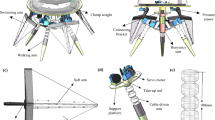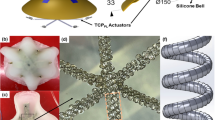Abstract
This paper considers aquatic swimming of a pedundulatory bio-robotic system, inspired by the outstanding aquatic and terrestrial locomotion capabilities of the polychaete annelid marine worms. The robot employs lateral undulations of its elongated body, augmented by the oscillation of active lateral appendages (parapodia), to propel itself. The efficient propulsion and terrain adaptability of such robots on unstructured terrestrial substrates have been demonstrated in previous work. Here, we explore gait generation for underwater propulsion by direct (tail-to-head) lateral body waves, either alone (undulatory modes) or combined with appropriately coordinated parapodial motion (pedundulatory modes). A three-segment compliant-body robotic prototype is used, whose body was fabricated by molding polyurethane elastomers. This robot was tested in a laboratory water tank, to demonstrate the advantage gained from the exploitation of both tail-to-head body undulations and parapodia for underwater swimming. The forward speed may more than double and the propulsive force may increase ten-fold, compared to the case where only undulations are used.
Access this chapter
Tax calculation will be finalised at checkout
Purchases are for personal use only
Similar content being viewed by others
Notes
- 1.
A supplementary video with footage from these experiments can be downloaded from http://tinyurl.com/LM18-forth.
References
Yang, G.Z., Bellingham, J., Dupont, P.E., Fischer, P., Floridi, L., Full, R., Jacobstein, N., Kumar, V., McNutt, M., Merrifield, R., Nelson, B., Scassellati, B., Taddeo, M., Taylor, R., Veloso, M., Lin Wang, Z., Wood, R.: The grand challenges of science robotics. Sci. Robot. 3, eaar7650 (2018)
Cho, K.-J., Wood, R.: Biomimetic robots. In: Siciliano, B., Khatib, O. (eds.) Springer Handbook of Robotics, pp. 543–574. Springer, Cham (2016). https://doi.org/10.1007/978-3-319-32552-1_23
Iida, F., Ijspeert, A.J.: Biologically inspired robotics. In: Siciliano, B., Khatib, O. (eds.) Springer Handbook of Robotics, pp. 2015–2034. Springer, Cham (2016). https://doi.org/10.1007/978-3-319-32552-1_75
Liljebäck, P., Pettersen, K., Stavdahl, Ø., Gravdahl, J.: A review on modelling, implementation, and control of snake robots. Robot. Auton. Syst. 60, 29–40 (2012)
Crespi, A., Karakasiliotis, K., Guignard, A., Ijspeert, A.J.: Salamandra robotica ii: an amphibious robot to study salamander-like swimming and walking gaits. IEEE T-RO 29(2), 308–320 (2013)
Yamada, H., Takaoka, S., Hirose, S.: A snake-like robot for realworld inspection applications (the design and control of a practical active cord mechanism). Adv. Robot. 27, 47–60 (2013)
Gray, J.: Annelids. In: Animal Locomotion, Weidenfeld & Nicolson, pp. 377–410 (1968)
Gray, J.: Studies in animal locomotion. JEB 13(2), 192–199 (1936)
Brusca, R., Brusca, G.: Invertebrates. Sinauer Associates, Sunderland (1990)
Clark, R.B., Tritton, D.J.: Swimming mechanisms in nereidiform polychaetes. J. Zool. 161, 257–271 (1970)
Clark, R.B., Hermans, C.: Kinetics of swimming in some smooth-bodied polychaetes. J. Zool. 178, 145–159 (1976)
Hesselberg, T.: Biomimetics and the case of the remarkable ragworms. Naturwissenschaften 94(8), 613 (2007)
Wootton, R.: Invertebrate paraxial locomotory appendages: design, deformation and control. JEB 202(23), 3333–3345 (1999)
Clark, R.B.: Undulatory swimming in polychaetes. In: Perspectives in Experimental Biology, pp. 437–446 (1976)
Mettam, C.: Segmental musculature and parapodial movement of Nereis diversicolor and Nephthys hombergi (Annelida: Polychaeta). J. Zool. 153(2), 245–275 (1967). The Linnean Society of New South Wales
Mettam, C.: Functional morphology of locomotion in Chloeia (Polychaeta; Amphinomidae). In: Huchings, P.A. (ed.) Proceedings First International Polychaete Conference, pp. 390–400. The Linnean Society of New South Wales (1984)
Lawry Jr., J.V.: Mechanisms of locomotion in the polychaete, Harmothoë. Comp. Biochem. Phys. 37(2), 167–179 (1970)
Sfakiotakis, M., Tsakiris, D.P., Karakasiliotis, K.: Polychaete-like pedundulatory robotic locomotion. In: Proceedings of the IEEE International Conference on Robotics and Automation, (ICRA 2007), pp. 269–274 (2007)
Sfakiotakis, M., Tsakiris, D.P.: Pedundulatory robotic locomotion: centipede and polychaete modes in unstructured substrates. In: Proceedings of the International Conference on Robotics and Biomimetics (ROBIO 2008), pp. 651–658 (2009)
La Spina, G., Sfakiotakis, M., Tsakiris, D.P., Menciassi, A., Dario, P.: Polychaete-like undulatory robotic locomotion in unstructured substrates. IEEE T-RO 6, 1200–1212 (2007)
Sfakiotakis, M., Tsakiris, D.P.: SIMUUN: a simulation environment for undulatory locomotion. Int. J. Model. Simul. 26(4), 350–358 (2006). Taylor & Francis
Sfakiotakis, M., Tsakiris, D.P.: A biomimetic centering behavior for undulatory robots. IJRR 26(11–12), 1267–1282 (2007)
Sfakiotakis, M., Tsakiris, D.P.: Undulatory and pedundulatory robotic locomotion via direct and retrograde body waves. In: Proceedings of the IEEE International Conference on Robotics and Automation (ICRA 2009), pp. 3457–3463 (2009)
Sfakiotakis, M., Chatzidaki, A., Evdaimon, T., Kazakidi, A., Tsakiris, D.P.: Effects of compliance in pedundulatory locomotion over granular substrates. In: Proceedings of the 24th Mediterranean Conference on Control and Automation (MED), pp. 532–538, June 2016
Semenov, A.: Metallic snake-nereis pellagica (2008). https://www.flickr.com/photos/a_semenov/3099126862
Vogel, S.: Modes and scaling in aquatic locomotion. Integr. Comp. Biol. 48(6), 702–712 (2008)
Nachtigall, W.: Hydromechanics and biology. Biophys. Struct. Mech. 8(1), 1–22 (1981)
Porez, M., Boyer, F., Ijspeert, A.J.: Improved lighthill fish swimming model for bio-inspired robots: modeling, computational aspects and experimental comparisons. IJRR 33(10), 1322–1341 (2014)
Gazzola, M., Argentina, M., Mahadevan, L.: Gait and speed selection in slender inertial swimmers. PNAS 112(13), 3874–3879 (2015)
Taylor, G.: Analysis of the swimming of long and narrow animals. Proc. R. Soc. Lond. A: Math. Phys. Eng. Sci. 214(1117), 158–183 (1952)
McIsaac, K.A., Ostrowski, J.P.: Motion planning for anguilliform locomotion. IEEE Trans. Robot. Autom. 19(4), 637–652 (2003)
Ekeberg, Ö.: A combined neuronal and mechanical model of fish swimming. Biol. Cybern. 69(5–6), 363–374 (1993)
Ijspeert, A.J.: A connectionist central pattern generator for the aquatic and terrestrial gaits of a simulated salamander. Biol. Cybern. 85(5), 331–348 (2001)
Ge, L., Sotiropoulos, F.: A numerical method for solving the 3D unsteady incompressible navier-stokes equations in curvilinear domains with complex immersed boundaries. J. Comput. Phys. 225, 1782–1809 (2007)
Kazakidi, A., Tsakiris, D.P., Ekaterinaris, J.A.: Propulsive efficiency in drag-based locomotion of a reduced-size swimmer with various types of appendages. Comput. Fluids 167, 241–248 (2018)
Acknowledgement
This work was supported in part by the project “Advanced Research Activities in Biomedical & Agroalimentary Technologies” (MIS 5002469) implemented under the “Action for the Strategic Development on the Research & Technological Sector”, funded by the Operational Programme “Competitiveness, Entrepreneurship & Innovation” (NSRF 2014–2020), co-financed by Greece and the European Union (European Regional Development Fund).
Author information
Authors and Affiliations
Corresponding author
Editor information
Editors and Affiliations
Rights and permissions
Copyright information
© 2018 Springer International Publishing AG, part of Springer Nature
About this paper
Cite this paper
Tsakiris, D.P., Evdaimon, T., Papadakis, E. (2018). Aquatic Swimming of a Multi-functional Pedundulatory Bio-Robotic Locomotor. In: Vouloutsi , V., et al. Biomimetic and Biohybrid Systems. Living Machines 2018. Lecture Notes in Computer Science(), vol 10928. Springer, Cham. https://doi.org/10.1007/978-3-319-95972-6_53
Download citation
DOI: https://doi.org/10.1007/978-3-319-95972-6_53
Published:
Publisher Name: Springer, Cham
Print ISBN: 978-3-319-95971-9
Online ISBN: 978-3-319-95972-6
eBook Packages: Computer ScienceComputer Science (R0)




